The Life Span of a Cockroach
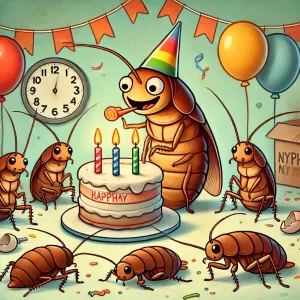 Cockroaches are known for their resilience and ability to survive in various environments, making them one of the most successful pests on the planet. A key aspect of their survival is their life span, which can vary significantly depending on the species and environmental conditions. In this article, we’ll explore the life cycle of cockroaches, their typical life span, and factors that influence their longevity.
Cockroaches are known for their resilience and ability to survive in various environments, making them one of the most successful pests on the planet. A key aspect of their survival is their life span, which can vary significantly depending on the species and environmental conditions. In this article, we’ll explore the life cycle of cockroaches, their typical life span, and factors that influence their longevity.
The Life Cycle of a Cockroach
Stages of Development
Cockroaches undergo three main stages of development:
- Egg: Cockroach eggs are encased in a protective shell called an ootheca. The number of eggs within an ootheca varies by species.
- Nymph: Once hatched, young cockroaches, known as nymphs, emerge. Nymphs look like smaller versions of adult cockroaches but lack fully developed wings and reproductive organs.
- Adult: After undergoing several molts, where they shed their exoskeleton, nymphs mature into adults with fully developed wings (in most species) and reproductive capabilities.
Typical Life Span of Common Cockroach Species
American Cockroach (Periplaneta americana)
- Life Span: Approximately 1 year.
- Development Time: It takes about 6-12 months for an American cockroach to develop from an egg to an adult.
- Notable Traits: Known for their large size and ability to fly.
German Cockroach (Blattella germanica)
- Life Span: Approximately 100-200 days.
- Development Time: It takes about 2-3 months for a German cockroach to develop from an egg to an adult.
- Notable Traits: Highly prolific, with females producing multiple oothecae during their life span.
Oriental Cockroach (Blatta orientalis)
- Life Span: Approximately 6 months to 2 years.
- Development Time: It takes about 6-12 months for an Oriental cockroach to develop from an egg to an adult.
- Notable Traits: Prefer cooler, damp environments and are often found in basements and drains.
Brown-Banded Cockroach (Supella longipalpa)
- Life Span: Approximately 130-200 days.
- Development Time: It takes about 3-5 months for a Brown-Banded cockroach to develop from an egg to an adult.
- Notable Traits: Tend to prefer warmer, drier environments and are often found in higher locations within buildings.
Factors Influencing Cockroach Life Span
Environmental Conditions
- Temperature: Cockroaches thrive in warm environments. Higher temperatures generally speed up their development and reproductive cycles.
- Humidity: Adequate moisture is crucial for cockroach survival. They prefer humid environments and are often found in areas with high moisture levels.
- Food Availability: An abundant food supply can extend the life span of cockroaches by providing the necessary nutrients for growth and reproduction.
Predation and Disease
- Natural Predators: Cockroaches face predation from various animals, including birds, reptiles, and other insects.
- Diseases and Parasites: Cockroaches can be affected by diseases and parasites, which can reduce their life span.
Human Interventions
- Pest Control Measures: Effective pest control strategies can significantly reduce the life span of cockroaches in infested areas. These measures include the use of insecticides, baits, and traps.
- Sanitation Practices: Maintaining a clean environment reduces the availability of food and water sources, thereby limiting the survival and reproduction of cockroaches.
The life span of a cockroach varies depending on the species and environmental conditions. While some cockroaches can live up to two years, others have much shorter life spans. Understanding the factors that influence their longevity can help in developing effective pest control strategies to manage and reduce cockroach populations.
If you’re dealing with a cockroach infestation, consider implementing comprehensive pest control measures, including proper sanitation, sealing entry points, and using baits and traps. For persistent infestations, professional pest control services can provide targeted solutions to eliminate cockroaches from your home or business. Explore our other articles for more tips and information on managing cockroach infestations effectively.
Do Cockroaches Eat Clothes?
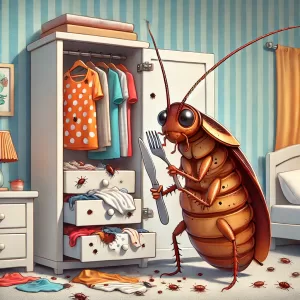 Cockroaches are notorious for their ability to survive in various environments and their indiscriminate eating habits. While they are commonly known to feed on food scraps, decaying matter, and even other insects, a question that often arises is whether cockroaches eat clothes. In this article, we’ll explore the eating habits of cockroaches, whether they pose a threat to your wardrobe, and how to protect your clothes from these resilient pests.
Cockroaches are notorious for their ability to survive in various environments and their indiscriminate eating habits. While they are commonly known to feed on food scraps, decaying matter, and even other insects, a question that often arises is whether cockroaches eat clothes. In this article, we’ll explore the eating habits of cockroaches, whether they pose a threat to your wardrobe, and how to protect your clothes from these resilient pests.
Cockroach Diet: An Overview
Omnivorous Scavengers
Cockroaches are omnivorous scavengers, meaning they will eat almost anything organic. Their diet typically includes:
- Food scraps
- Decaying plant and animal matter
- Starches and sugars
- Paper and cardboard
- Other insects
Nutritional Needs
Cockroaches require a diet rich in carbohydrates, proteins, and fats. They are attracted to food sources that can provide these nutrients, which is why they are often found in kitchens and garbage areas.
Do Cockroaches Eat Clothes?
Attraction to Clothes
While cockroaches do not specifically seek out clothes as a food source, they may be attracted to fabrics for several reasons:
- Food Residues: Clothes that have food stains, sweat, or body oils can attract cockroaches. The organic residues left on the fabric can provide the nutrients they need.
- Starch-Based Fabrics: Some fabrics, especially those treated with starch, can attract cockroaches. They may chew on these materials to access the starch content.
Damage to Clothes
When cockroaches come into contact with clothes, they can cause damage in a few ways:
- Chewing Holes: While rare, cockroaches may chew small holes in fabrics, especially if the clothes are heavily soiled with organic matter.
- Stains and Odors: Cockroaches can leave behind droppings and secretions that stain fabrics and create unpleasant odors.
How to Protect Your Clothes from Cockroaches
Regular Cleaning
- Wash Clothes Regularly: Ensure that clothes are washed regularly to remove any food residues, sweat, or body oils that may attract cockroaches.
- Store Clean Clothes: Store clean clothes in sealed containers or garment bags to prevent access by cockroaches.
Proper Storage
- Use Airtight Containers: Store clothes in airtight containers, especially if they are not used frequently. This will prevent cockroaches from accessing the fabrics.
- Vacuum-Sealed Bags: Consider using vacuum-sealed bags for long-term storage. These bags not only save space but also protect clothes from pests.
Maintain Clean Living Spaces
- Regular House Cleaning: Keep your living spaces clean to reduce the overall risk of cockroach infestations. Pay special attention to areas where food is prepared and consumed.
- Declutter: Reduce clutter in your home, as it provides hiding places for cockroaches.
Natural Repellents
- Essential Oils: Use essential oils like lavender, peppermint, or eucalyptus in your closets and storage areas. Cockroaches dislike these scents and may avoid areas where they are present.
- Cedar Chips: Place cedar chips in closets and drawers. Cedar is a natural repellent for many insects, including cockroaches.
Professional Pest Control
If you have a severe cockroach infestation, it may be necessary to seek professional pest control services. Professionals can provide targeted treatments and comprehensive solutions to eliminate cockroaches from your home.
While cockroaches do not typically eat clothes, they can be attracted to fabrics that contain organic residues or are treated with starch. By maintaining cleanliness, properly storing clothes, and using natural repellents, you can protect your wardrobe from potential damage caused by cockroaches. If you suspect a serious infestation, professional pest control services can help ensure your home remains pest-free.
Take proactive steps to protect your clothes and home from cockroaches. Regular cleaning, proper storage, and preventive measures are key to keeping these pests at bay. If you need help, don’t hesitate to contact a professional pest control service for expert assistance.
Do Cockroaches Have Teeth?
Shrimps and Cockroaches
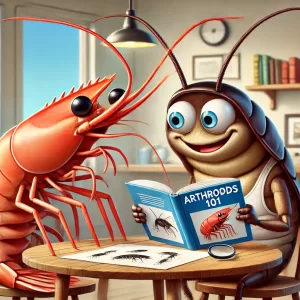 What Do Shrimps and Cockroaches Have in Common?
What Do Shrimps and Cockroaches Have in Common?
Shrimps and cockroaches might seem worlds apart, with one living in the ocean and the other often invading our homes. However, these two creatures share some surprising similarities. In this article, we’ll explore the fascinating connections between shrimps and cockroaches, as well as their key differences.
Taxonomy and Classification
Arthropods Both shrimps and cockroaches belong to the phylum Arthropoda, a group characterized by their exoskeletons, segmented bodies, and jointed appendages.
- Shrimps: Part of the class Malacostraca, which also includes crabs and lobsters.
- Cockroaches: Part of the class Insecta, which includes a vast number of insect species.
Physical Characteristics
Exoskeleton Both shrimps and cockroaches have a hard exoskeleton made of chitin, which provides protection and support.
Segmentation Their bodies are divided into segments:
- Shrimps: Typically have a segmented body divided into the cephalothorax and abdomen.
- Cockroaches: Have a body divided into the head, thorax, and abdomen.
Habitats
Shrimps
- Marine and Freshwater: Shrimps are found in both marine and freshwater environments. They play a crucial role in the aquatic food chain.
- Habitats: Commonly inhabit coastal areas, rivers, and streams.
Cockroaches
- Terrestrial: Cockroaches are primarily land-dwellers, thriving in warm, moist environments.
- Habitats: Commonly found in homes, forests, and tropical regions.
Diet and Feeding
Shrimps
- Omnivorous: Shrimps have a varied diet, including algae, plankton, and detritus.
- Feeding Behavior: They use their appendages to filter food from the water or scavenge along the ocean floor.
Cockroaches
- Omnivorous: Cockroaches eat a wide range of organic matter, from food scraps to decaying material.
- Feeding Behavior: They have powerful mouthparts to chew through a variety of substances.
Reproduction
Shrimps
- Egg-Laying: Female shrimps lay eggs, which are often carried under their abdomen until they hatch.
- Larvae: The eggs hatch into free-swimming larvae, which eventually develop into adult shrimps.
Cockroaches
- Egg Cases (Oothecae): Female cockroaches produce egg cases, each containing multiple eggs.
- Nymphs: The eggs hatch into nymphs, which undergo several molts before becoming adults.
Common Misconceptions
Shrimps and Cockroaches as Relatives While shrimps and cockroaches are distant relatives within the arthropod phylum, they belong to different classes and have distinct evolutionary paths.
Shrimps in Cuisine vs. Cockroaches as Pests
- Shrimps: Considered a delicacy in many cuisines around the world.
- Cockroaches: Generally seen as pests, although they are consumed in some cultures as a source of protein.
Interesting Facts
Survival Skills
- Shrimps: Can escape predators by quickly flicking their tails and propelling themselves backward.
- Cockroaches: Known for their resilience, can survive without food for weeks and endure harsh conditions.
While shrimps and cockroaches have distinct differences, their shared characteristics as arthropods reveal some fascinating connections. Understanding these similarities and differences can deepen our appreciation for the diversity of life on Earth.
Explore more about the intriguing world of arthropods and learn how to manage cockroach infestations effectively by browsing our other articles and resources. If you’re dealing with a pest problem, consider professional pest control services for expert assistance.
Will Sleeping with the Light On Keep Cockroaches Away?
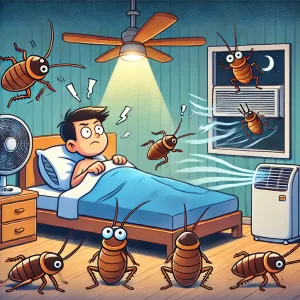 Cockroaches are nocturnal pests that tend to come out at night, often leading people to wonder if sleeping with the light on can keep them away. This article explores whether keeping the lights on can deter cockroaches and provides practical tips for preventing and managing cockroach infestations. We will also look into the effects of ceiling fans and room temperature on cockroach activity.
Cockroaches are nocturnal pests that tend to come out at night, often leading people to wonder if sleeping with the light on can keep them away. This article explores whether keeping the lights on can deter cockroaches and provides practical tips for preventing and managing cockroach infestations. We will also look into the effects of ceiling fans and room temperature on cockroach activity.
The Behavior of Cockroaches
Nocturnal Activity
Cockroaches are nocturnal creatures, meaning they are most active during the night. They prefer darkness as it provides cover from predators and allows them to forage for food and water without disturbance.
Sensitivity to Light
While cockroaches are typically averse to bright light, they are not entirely deterred by it. They may avoid well-lit areas but will not necessarily abandon a space simply because the lights are on. They might find darker corners and crevices to hide in until it’s safe to come out.
Does Sleeping with the Light On Help?
Temporary Deterrent
Sleeping with the light on may serve as a temporary deterrent for cockroaches. The light might discourage them from venturing out into the open, but it will not eliminate them from your home. Cockroaches are highly adaptable and can find ways to navigate around the light to reach their food and water sources.
Not a Long-Term Solution
Keeping the light on is not a sustainable solution for cockroach infestations. Cockroaches can still find food and shelter in hidden, dark areas of your home, and their presence will persist regardless of whether the lights are on or off.
Can a Ceiling Fan Help?
Air Movement
Running a ceiling fan can create air movement that might make it more difficult for cockroaches to navigate. The constant airflow could act as a mild deterrent, making the environment less comfortable for them.
Noise and Vibration
The noise and vibration from a ceiling fan might also help keep cockroaches away. These pests prefer quiet, undisturbed areas, so the presence of a running fan could make them less likely to come out.
Effectiveness
While a ceiling fan may have some impact, it is not a guaranteed solution to keep cockroaches away. It can be part of a broader strategy to make your home less hospitable to these pests.
Does Room Temperature Affect Cockroaches?
Preference for Warmth
Cockroaches thrive in warm environments, which provide the ideal conditions for their survival and reproduction. Lowering the room temperature can make the environment less hospitable for them.
Using Temperature as a Deterrent
- Cooler Temperatures: Keeping your home cooler, especially at night, can make it less attractive to cockroaches. They are less active in cooler environments and may seek warmer areas to hide.
- Air Conditioning: Running an air conditioner can help maintain a lower temperature and reduce humidity, both of which are unfavorable for cockroaches.
Limitations
While adjusting the temperature can help, it should not be relied upon as the sole method for controlling cockroach infestations. It is most effective when combined with other preventive and control measures.
Effective Ways to Keep Cockroaches Away
Maintain Cleanliness
- Regular Cleaning: Keep your home clean, especially the kitchen and dining areas, to remove food crumbs and spills.
- Proper Food Storage: Store food in sealed containers and promptly dispose of garbage.
Eliminate Moisture
- Fix Leaks: Repair any leaky faucets and pipes to reduce moisture levels.
- Use Dehumidifiers: Use dehumidifiers in damp areas to make your home less inviting to cockroaches.
Seal Entry Points
- Close Off Cracks and Gaps: Use caulk and weather stripping to seal cracks and gaps where cockroaches might enter.
- Install Screens: Ensure that windows and vents have tight-fitting screens to keep cockroaches out.
Use Traps and Baits
- Traps: Place sticky traps in areas where you have seen cockroach activity to monitor and reduce their numbers.
- Baits: Use cockroach baits in strategic locations to attract and kill cockroaches.
Professional Pest Control
For severe infestations, consider hiring a professional pest control service. Professionals can provide comprehensive inspections and targeted treatments to effectively manage and eliminate cockroach populations.
Preventing Future Infestations
Regular Inspections
Conduct regular inspections of your home, paying close attention to dark, hidden areas where cockroaches might hide.
Maintenance and Repairs
Keep up with home maintenance and repairs to eliminate potential entry points and reduce conditions that attract cockroaches.
Conclusion
While sleeping with the light on, using a ceiling fan, or adjusting the room temperature might provide temporary deterrents, they are not effective long-term solutions for keeping cockroaches away. Maintaining cleanliness, reducing moisture, sealing entry points, and using traps and baits are more reliable methods for preventing and managing cockroach infestations. For persistent issues, professional pest control services can offer expert assistance.
Call to Action
If you’re dealing with a cockroach problem, take proactive steps to address it. Regular cleaning, moisture control, and sealing entry points are key to keeping these pests at bay. For severe infestations, don’t hesitate to contact a professional pest control service for expert help.
How to get roaches out of your car overnight
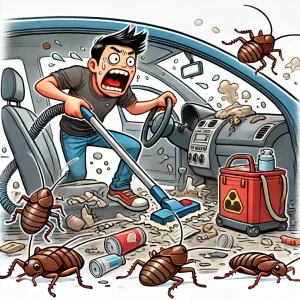 Finding roaches in your car can be unsettling and problematic. These pests not only cause discomfort but can also spread germs and allergens. Fortunately, there are effective methods to get rid of roaches quickly, even overnight. This guide will provide you with practical steps to eliminate roaches from your car and prevent future infestations.
Finding roaches in your car can be unsettling and problematic. These pests not only cause discomfort but can also spread germs and allergens. Fortunately, there are effective methods to get rid of roaches quickly, even overnight. This guide will provide you with practical steps to eliminate roaches from your car and prevent future infestations.
Step-by-Step Guide
1. Clean Out Your Car Thoroughly Roaches are attracted to food and clutter, so the first step is to remove anything that might attract them.
- Remove Trash: Take out all garbage, food wrappers, and other debris.
- Vacuum: Vacuum the seats, floors, and any crevices where food particles might have accumulated.
2. Use Roach Baits and Traps Placing baits and traps in strategic locations can help eliminate roaches quickly.
- Gel Baits: Apply roach gel baits in hidden areas like under the seats, in the glove compartment, and near the pedals.
- Sticky Traps: Place sticky traps in areas where you’ve seen roach activity.
3. Natural Repellents Natural repellents can help deter roaches without using harsh chemicals.
- Diatomaceous Earth: Sprinkle food-grade diatomaceous earth around the car. This substance dehydrates and kills roaches upon contact.
- Essential Oils: Use a spray bottle to apply a mixture of water and essential oils (like peppermint or eucalyptus) around the interior of the car. Roaches dislike the strong scent.
4. Insecticides and Foggers If the infestation is severe, you might need to use stronger measures.
- Car-Safe Insecticides: Use insecticides specifically designed for vehicles, and follow the instructions carefully.
- Foggers: Car foggers can be effective, but ensure you use them correctly and air out the car thoroughly before use.
5. Overnight Methods Implementing intensive methods overnight can make a big difference.
- Close Windows and Doors: After placing baits, traps, or foggers, ensure all windows and doors are closed to keep the treatment contained.
- Check in the Morning: Inspect the car in the morning, remove dead roaches, and clean any remaining debris.
6. Prevent Future Infestations Preventing roaches from returning is crucial to maintaining a clean car.
- Regular Cleaning: Keep your car clean and free of food crumbs and clutter.
- Storage of Food: Avoid eating in your car, or ensure that food is properly stored and disposed of.
- Sealing Entry Points: Check for and seal any potential entry points where roaches might get into your car.
Dealing with roaches in your car can be a nuisance, but with the right approach, you can eliminate them overnight. By thoroughly cleaning your car, using baits and traps, applying natural repellents, and possibly using insecticides or foggers, you can rid your vehicle of these pests. Regular maintenance and cleanliness will help prevent future infestations, ensuring your car remains roach-free.
If you’re struggling with a severe infestation or need additional help, consider consulting a professional pest control service. They can provide expert advice and treatment options to ensure your car is completely free of roaches.
Do Cockroaches Feel Pain?
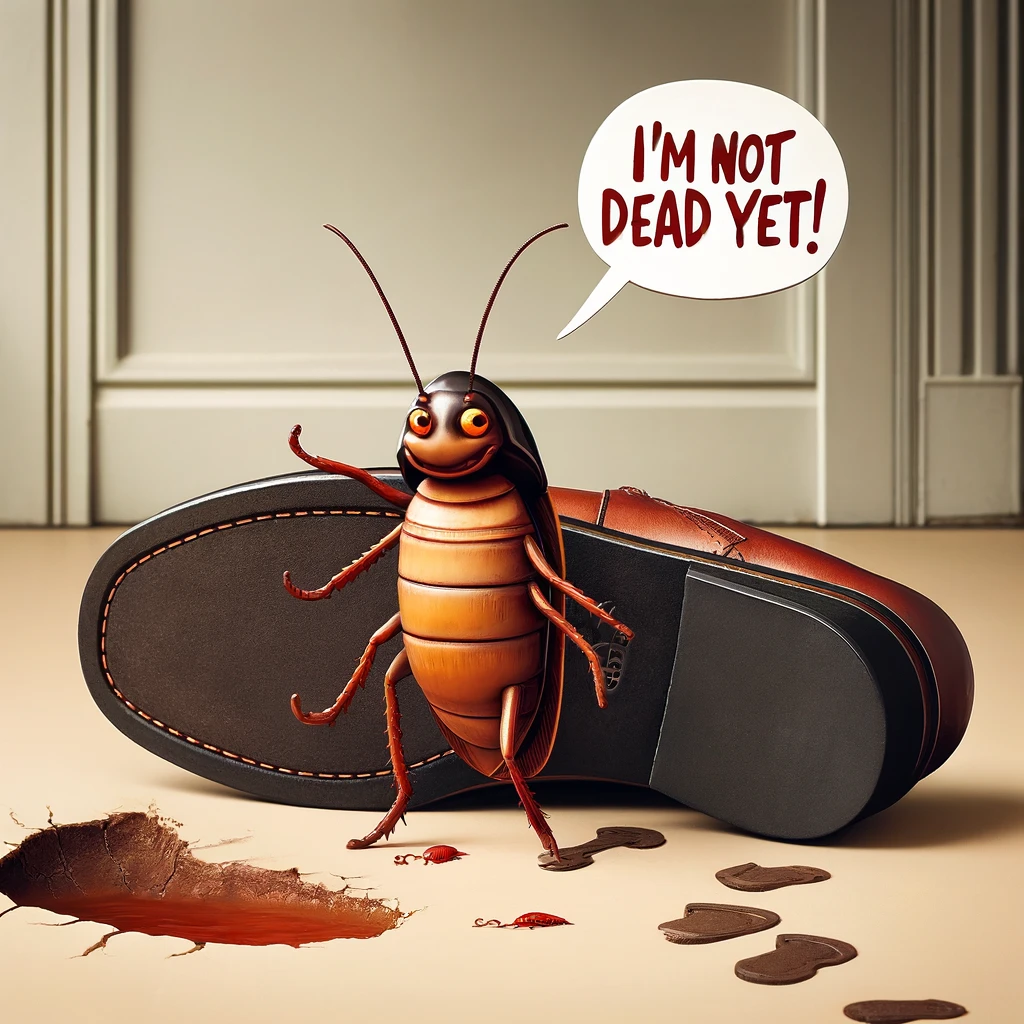 The question of whether cockroaches feel pain is a topic that piques the curiosity of many people, especially those dealing with infestations or considering humane pest control options. Understanding the sensory experiences of cockroaches can provide insights into their behavior and inform more compassionate approaches to pest management. In this article, we’ll explore the current scientific understanding of whether cockroaches feel pain, how their nervous systems function, and what this means for pest control practices.
The question of whether cockroaches feel pain is a topic that piques the curiosity of many people, especially those dealing with infestations or considering humane pest control options. Understanding the sensory experiences of cockroaches can provide insights into their behavior and inform more compassionate approaches to pest management. In this article, we’ll explore the current scientific understanding of whether cockroaches feel pain, how their nervous systems function, and what this means for pest control practices.
Understanding Pain Perception
Definition of Pain
Pain, in a biological context, is an unpleasant sensory and emotional experience associated with actual or potential tissue damage. In mammals, pain involves complex processes in the nervous system and brain, leading to conscious awareness and emotional responses.
Nociception vs. Pain
- Nociception: The detection of harmful stimuli by sensory neurons called nociceptors. This process can trigger reflex responses to avoid damage.
- Pain: A conscious experience that includes the emotional and psychological aspects of discomfort.
Cockroach Nervous System
Anatomy and Function
Cockroaches have a decentralized nervous system consisting of a brain and a series of ganglia (nerve cell clusters) distributed along their body. This structure allows them to perform complex behaviors even if part of their nervous system is damaged.
- Brain: Controls basic functions and behaviors.
- Ganglia: Each segment of the body has its own ganglia that control localized movements and reflexes.
Can Cockroaches Feel Pain?
Scientific Perspective
Current scientific evidence suggests that cockroaches, and insects in general, do not experience pain in the same way that humans and other animals with more complex nervous systems do. Here’s why:
- Lack of Emotional Response: Insects do not have the brain structures required for emotional responses, which are essential components of the pain experience.
- Reflexive Responses: Insects respond to harmful stimuli with reflexive actions rather than conscious, emotional reactions. For example, a cockroach might withdraw a leg if it senses heat, but this is a reflex rather than an experience of pain.
Studies and Research
Research on insect nociception shows that while insects can detect and respond to harmful stimuli, they do not process these signals as pain. Instead, their responses are automatic and aimed at survival rather than conscious suffering.
Ethical Considerations in Pest Control
Humane Practices
Understanding that cockroaches do not feel pain like humans does not negate the importance of humane pest control practices. Ethical considerations still play a role in how we manage pest populations.
Effective and Compassionate Methods
- Preventive Measures: Focus on preventing infestations through cleanliness, sealing entry points, and reducing moisture.
- Non-Toxic Solutions: Use traps and baits that do not cause prolonged suffering.
- Professional Pest Control: Hire professionals who use humane and effective methods for managing infestations.
While cockroaches do not feel pain in the same way that humans do, they are capable of detecting harmful stimuli and responding reflexively. This understanding can guide more informed and humane approaches to pest control. By focusing on preventive measures and using ethical pest management strategies, we can effectively deal with cockroach infestations without unnecessary cruelty.
If you’re dealing with a cockroach problem, consider humane and effective pest control options. Preventive measures, non-toxic solutions, and professional pest control services can help you manage infestations responsibly and compassionately. For more information on humane pest control practices, explore our other articles and resources.
How Many Legs Do Cockroaches Have?
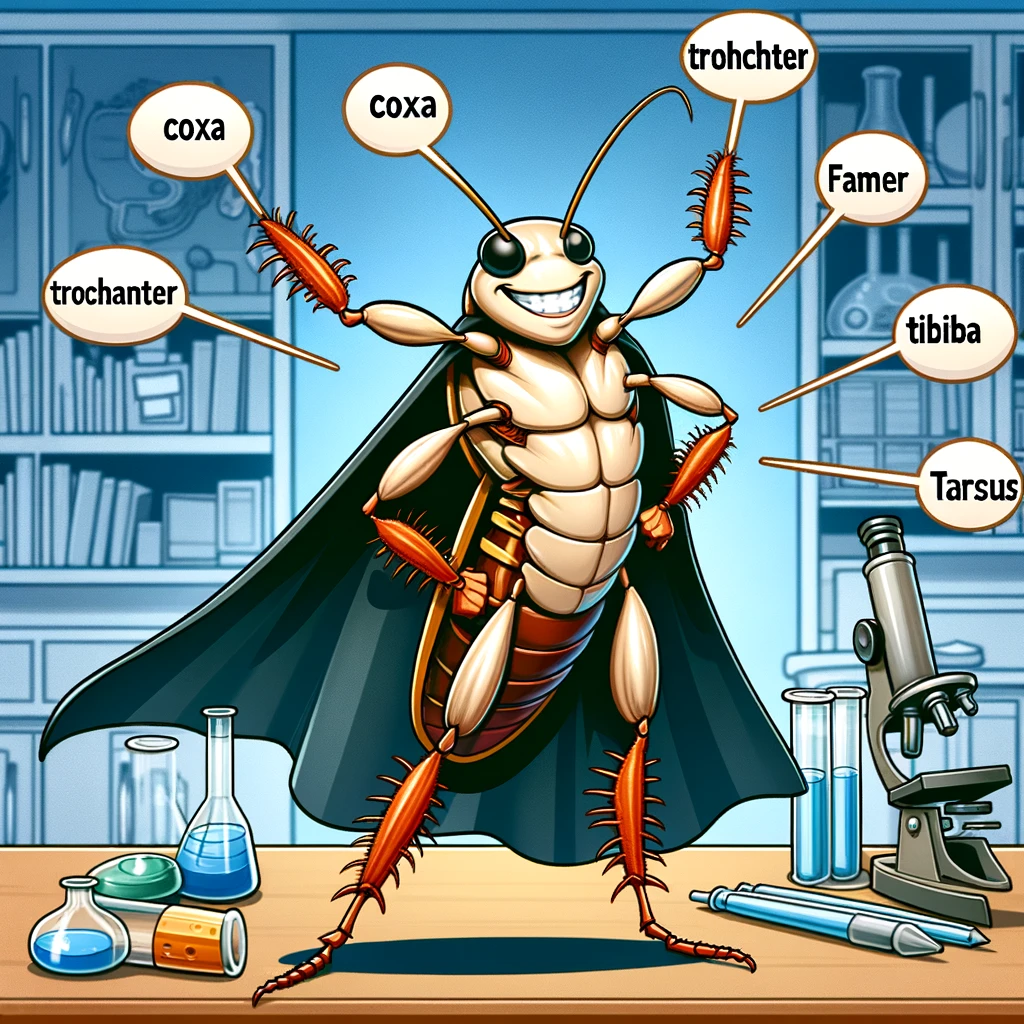 Cockroaches are fascinating yet often reviled insects that have been around for millions of years. One of the most distinctive features of cockroaches is their legs, which play a crucial role in their mobility and survival. In this article, we’ll explore how many legs cockroaches have, the anatomy of these legs, and their functions.
Cockroaches are fascinating yet often reviled insects that have been around for millions of years. One of the most distinctive features of cockroaches is their legs, which play a crucial role in their mobility and survival. In this article, we’ll explore how many legs cockroaches have, the anatomy of these legs, and their functions.
The Anatomy of Cockroach Legs
Number of Legs
Cockroaches, like all insects, have six legs. These legs are attached to the thorax, the middle segment of their body.
Leg Segments
Each cockroach leg is divided into several segments:
- Coxa: The base segment that attaches the leg to the body.
- Trochanter: The small segment following the coxa.
- Femur: The thick, muscular segment that provides strength.
- Tibia: The long, slender segment that extends from the femur.
- Tarsus: The foot-like segment divided into smaller parts, ending in claws that help with gripping surfaces.
Functions of Cockroach Legs
Movement
Cockroaches are known for their incredible speed and agility, which is largely due to their well-adapted legs. Their legs allow them to:
- Run Quickly: Cockroaches can move at impressive speeds, which helps them escape predators and find food.
- Climb Surfaces: The claws on their tarsus segments enable them to climb vertical surfaces and navigate through various environments.
Sensory Functions
Cockroach legs are equipped with sensory hairs and structures that help them detect changes in their environment. These sensory functions include:
- Detecting Vibrations: Sensory hairs can pick up vibrations in the ground, alerting cockroaches to approaching threats.
- Sensing Chemicals: Their legs can also detect chemical cues, aiding in finding food and mates.
Adaptations for Survival
Regeneration
One remarkable feature of cockroaches is their ability to regenerate lost legs. If a cockroach loses a leg due to predation or injury, it can regrow the limb over several molting cycles.
Specialized Legs
Different species of cockroaches have legs adapted to their specific habitats and lifestyles. For example:
- Burrowing Cockroaches: These cockroaches have strong, spade-like legs for digging.
- Climbing Cockroaches: Species that live in trees have legs with more developed claws for climbing.
Interesting Facts About Cockroach Legs
Speed and Agility
Cockroaches are among the fastest insects, capable of running at speeds up to 3 miles per hour. Their legs are perfectly designed for rapid, agile movements.
Orientation and Balance
Cockroaches use their legs not only for movement but also for maintaining balance and orientation. Their legs work in coordination with their antennae to navigate complex environments.
Cockroaches have six well-adapted legs that are crucial for their survival. These legs not only provide them with the ability to move quickly and escape threats but also play a role in their sensory perception and environmental adaptation. Understanding the anatomy and function of cockroach legs can provide insights into their remarkable resilience and adaptability.
If you’re dealing with a cockroach infestation, remember that their incredible mobility and ability to regenerate make them tough to eliminate. Regular cleaning, sealing entry points, and using effective pest control methods are essential. For severe infestations, consider contacting a professional pest control service for expert assistance.
Comparing Cockroach Eggs Size for Different Types of Cockroaches
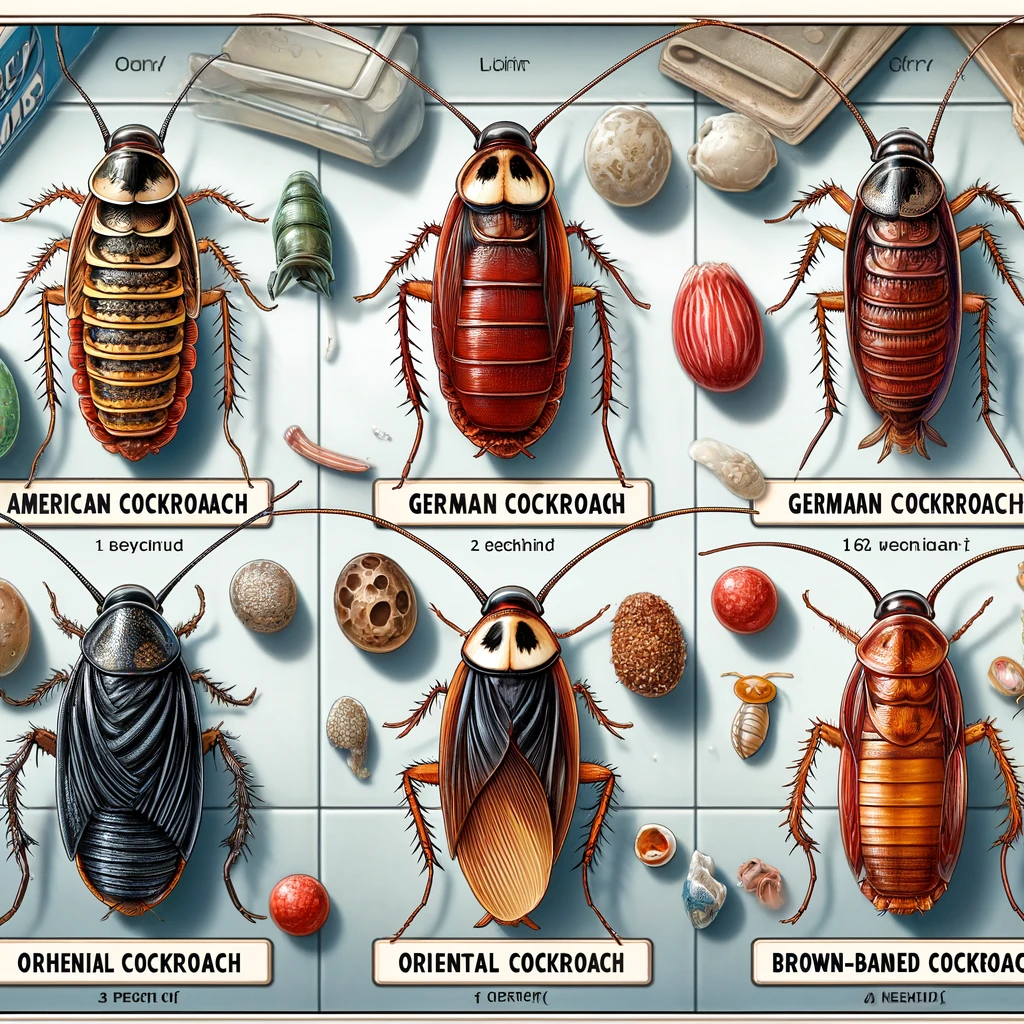 Cockroach infestations can escalate quickly due to their rapid reproduction. Understanding the size and appearance of cockroach eggs is crucial for early detection and effective pest control. In this article, we’ll explore the different sizes of cockroach eggs, how to identify them, and what steps you can take to prevent and control infestations.
Cockroach infestations can escalate quickly due to their rapid reproduction. Understanding the size and appearance of cockroach eggs is crucial for early detection and effective pest control. In this article, we’ll explore the different sizes of cockroach eggs, how to identify them, and what steps you can take to prevent and control infestations.
Understanding Cockroach Eggs
Egg Cases (Oothecae)
Cockroach eggs are typically encased in a protective shell called an ootheca. Each ootheca contains multiple eggs, which can vary in number depending on the species of cockroach. The ootheca provides protection and a safe environment for the developing eggs.
Sizes of Cockroach Eggs
American Cockroach (Periplaneta americana)
- Ootheca Size: Approximately 8-10 mm long.
- Number of Eggs: Each ootheca contains about 14-16 eggs.
- Appearance: Reddish-brown and ridged.
German Cockroach (Blattella germanica)
- Ootheca Size: Approximately 6-9 mm long.
- Number of Eggs: Each ootheca contains about 30-40 eggs.
- Appearance: Light brown and smooth.
Oriental Cockroach (Blatta orientalis)
- Ootheca Size: Approximately 8-10 mm long.
- Number of Eggs: Each ootheca contains about 16-18 eggs.
- Appearance: Dark brown to black and ridged.
Brown-banded Cockroach (Supella longipalpa)
- Ootheca Size: Approximately 5 mm long.
- Number of Eggs: Each ootheca contains about 10-18 eggs.
- Appearance: Light brown with distinctive horizontal bands.
Identifying Cockroach Eggs
Visual Identification
- Color and Texture: Cockroach oothecae vary in color and texture, ranging from smooth and light brown to ridged and dark brown.
- Size and Shape: The size and shape of the ootheca can help identify the species. Measure the length and look for specific characteristics like ridges or bands.
Common Locations
Cockroaches tend to lay their eggs in hidden, undisturbed areas. Common places to find cockroach eggs include:
- Kitchens: Under sinks, behind appliances, and inside cabinets.
- Bathrooms: Around plumbing fixtures and in cabinets.
- Basements and Crawl Spaces: In dark, damp areas.
Preventing and Controlling Cockroach Infestations
Sanitation
- Keep Your Home Clean: Regularly clean kitchens and bathrooms to remove food sources and reduce hiding spots.
- Proper Food Storage: Store food in airtight containers and promptly dispose of garbage.
Eliminate Hiding Spots
- Seal Cracks and Gaps: Use caulk or other sealants to close off entry points and hiding spots.
- Reduce Clutter: Remove unnecessary items that can serve as hiding spots for cockroaches.
Moisture Control
- Fix Leaks: Repair any leaky faucets or pipes to reduce moisture levels.
- Use Dehumidifiers: In damp areas, use dehumidifiers to lower humidity levels.
Using Baits and Insecticides
- Baits: Place cockroach baits in areas where you have identified cockroach activity. Baits are effective because they attract and poison the bugs.
- Insecticides: Use insecticides in targeted areas to reduce the cockroach population.
Professional Pest Control
For severe infestations, consider hiring a professional pest control service. Professionals can provide comprehensive inspections and targeted treatments to effectively manage and eliminate cockroach populations.
Cockroach eggs are a key factor in the rapid spread of infestations. By understanding the size and appearance of these eggs, you can take early action to control and prevent cockroach problems in your home. Regular cleaning, moisture control, and sealing entry points are essential steps in maintaining a cockroach-free environment.
If you suspect a cockroach infestation in your home, take immediate steps to address it. Regular inspections, sanitation, and targeted pest control measures are crucial. For persistent infestations, contact a professional pest control service for expert assistance.
Identifying a Cockroach Bite on the Lips or Face
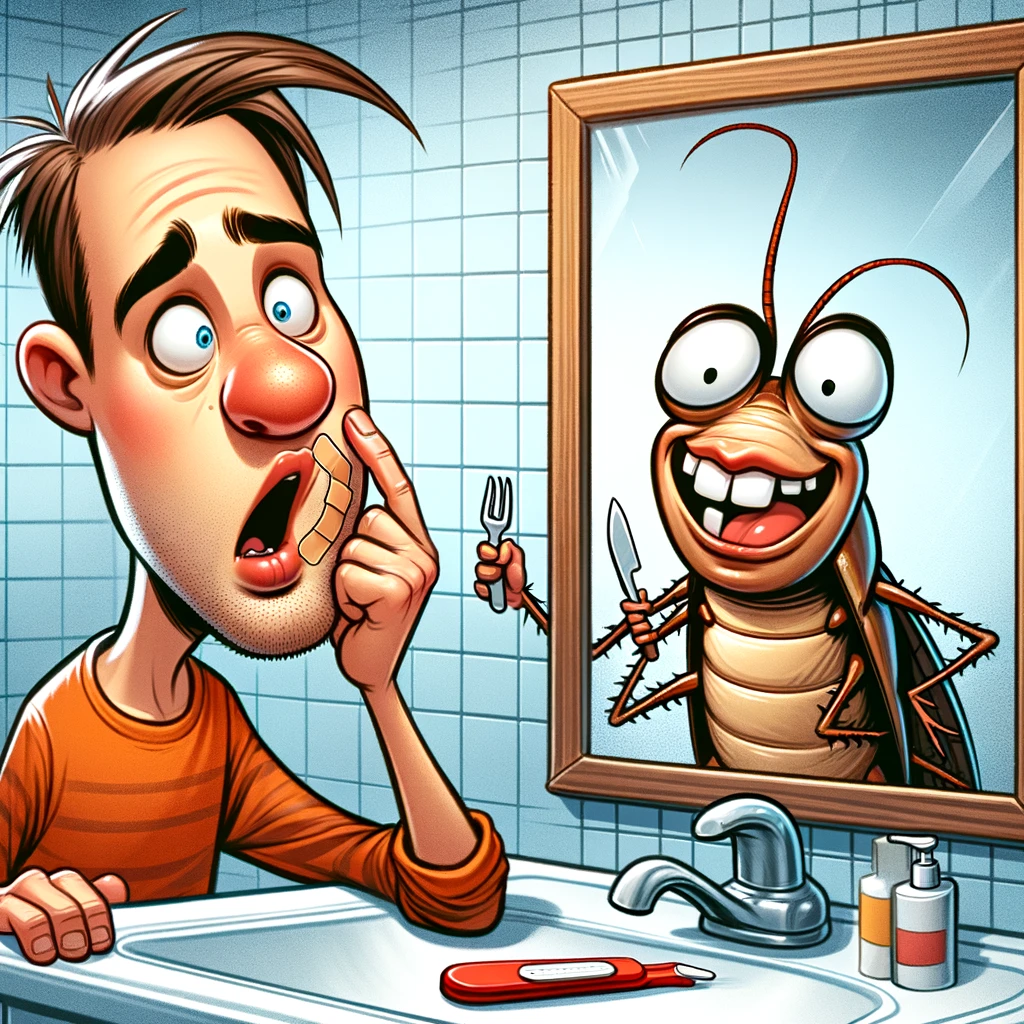 Cockroach bites are relatively rare, but they can happen, particularly in cases of severe infestations. One particularly unsettling possibility is a cockroach bite on the lips. This article explores why cockroaches might bite lips, the symptoms of such bites, and what you can do to treat and prevent them.
Cockroach bites are relatively rare, but they can happen, particularly in cases of severe infestations. One particularly unsettling possibility is a cockroach bite on the lips. This article explores why cockroaches might bite lips, the symptoms of such bites, and what you can do to treat and prevent them.
Why Do Cockroaches Bite?
Scavenging Behavior
Cockroaches are omnivorous scavengers that will eat almost anything, including food residues and dead organic matter. They typically bite humans only when food is scarce and they are in survival mode.
Attraction to Moisture
Cockroaches are attracted to moisture and food particles, which can often be found around a person’s mouth while they sleep. This attraction might lead them to explore and potentially bite the lips.
Symptoms of a Cockroach Bite on Lips
Physical Appearance
- Redness and Swelling: The area around the bite may become red and swollen.
- Bite Marks: Small puncture marks may be visible where the cockroach’s mouthparts broke the skin.
- Itching and Pain: The bite may cause itching and discomfort.
Possible Reactions
- Allergic Reaction: Some people may experience an allergic reaction to the bite, leading to increased swelling, itching, and redness.
- Infection Risk: If the bite area is scratched excessively or not kept clean, there is a risk of secondary infection.
First Aid for Cockroach Bites on Lips
Immediate Steps
- Clean the Area: Gently wash the bite area with soap and water to reduce the risk of infection.
- Apply a Cold Compress: Use a cold compress to reduce swelling and relieve pain.
- Avoid Scratching: Try not to scratch the bite, as this can lead to infection.
Over-the-Counter Treatments
- Antihistamines: Oral antihistamines can help reduce itching and allergic reactions.
- Hydrocortisone Cream: Applying hydrocortisone cream can reduce inflammation and itching.
- Antiseptic Cream: Use an antiseptic cream to prevent infection.
When to See a Doctor
Seek medical attention if you experience severe symptoms, such as:
- Difficulty Breathing: This could indicate a serious allergic reaction.
- Spreading Redness and Swelling: Signs of a possible infection.
- Persistent Pain and Discomfort: If the symptoms do not improve with basic first aid.
Preventing Cockroach Bites
Maintain Cleanliness
- Regular Cleaning: Keep your home clean, especially the kitchen and dining areas, to remove food residues that attract cockroaches.
- Proper Food Storage: Store food in sealed containers and dispose of garbage regularly.
Reduce Moisture
- Fix Leaks: Repair any leaky faucets and pipes to reduce moisture levels.
- Use Dehumidifiers: Use dehumidifiers in damp areas to make your home less inviting to cockroaches.
Seal Entry Points
- Close Off Cracks and Gaps: Use caulk and weather stripping to seal cracks and gaps where cockroaches might enter.
- Install Screens: Ensure that windows and vents have tight-fitting screens to keep cockroaches out.
Use Traps and Baits
- Traps: Place sticky traps in areas where you have seen cockroaches to monitor and reduce their numbers.
- Baits: Use cockroach baits in strategic locations to attract and kill cockroaches.
Professional Pest Control
For severe infestations, consider hiring a professional pest control service. Professionals can provide comprehensive inspections and targeted treatments to effectively manage and eliminate cockroach populations.
While the idea of a cockroach biting your lips is unsettling, such incidents are rare and can be managed with proper first aid and preventive measures. By maintaining cleanliness, reducing moisture, and sealing entry points, you can significantly reduce the risk of cockroach infestations and bites. If you experience a bite, follow the recommended steps for treatment and seek medical attention if necessary.
Stay proactive in your efforts to prevent cockroach infestations. Regular cleaning, moisture control, and sealing entry points are key to keeping these pests at bay. If you need help, don’t hesitate to contact a professional pest control service for expert assistance.
Free Reports
- The Life Span of a Cockroach
- Do Cockroaches Eat Clothes?
- Do Cockroaches Have Teeth?
- Shrimps and Cockroaches
- Will Sleeping with the Light On Keep Cockroaches Away?
- How to get roaches out of your car overnight
- Do Cockroaches Feel Pain?
- How Many Legs Do Cockroaches Have?
- Comparing Cockroach Eggs Size for Different Types of Cockroaches
- Identifying a Cockroach Bite on the Lips or Face
- Black Water Bug Identification and Control
- Why Do Water Bugs Come Out At Night?
- What Does Roach Rash Look Like?
- Can Cockroaches Bite Your Eyelid?
- Can Cockroaches Live in Your Balls?
- How did cockroaches get their name?
- Why Do Cockroaches Shed Their Skin?
- What Smell do Palmetto Bugs Hate?
- Baby Palmetto Bug: Identification and Control
- Cockroach Eggs vs Poop: How to Tell the Difference
- How to Get Rid of Water Bugs
- How Long Can a Cockroach Live Without Air?
- The Lifecycle of the German Cockroach: From Egg to Adult
- Do Mice Eat Roaches
- Wood Roach vs. Cockroach
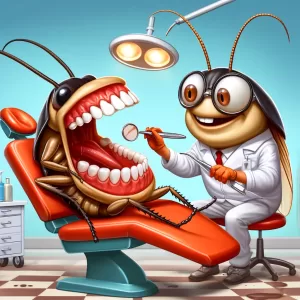 Cockroaches are fascinating creatures with many unique features, but one question that often arises is whether they have teeth. Understanding the anatomy of cockroaches, including their mouthparts, can provide insights into how they feed and survive. In this article, we’ll explore the structure of cockroach mouthparts, how they function, and the role they play in the cockroach’s daily life.
Cockroaches are fascinating creatures with many unique features, but one question that often arises is whether they have teeth. Understanding the anatomy of cockroaches, including their mouthparts, can provide insights into how they feed and survive. In this article, we’ll explore the structure of cockroach mouthparts, how they function, and the role they play in the cockroach’s daily life.